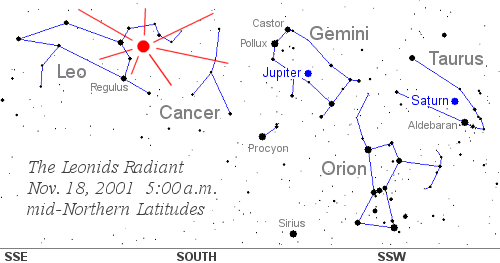See the Leonid Meteor Shower!
The UMD Astronomy Observatory Remains Closed
Fall 2024 Update: The UMD Astronomy Observatory remains closed to all public outreach activities.
Every year between November 14 and 20, the Earth collides with debris from Comet Tempel-Tuttle. This debris falls through the atmosphere and becomes the Leonid Meteor Shower, so named because the meteors appear to originate from the mane of the lion of the constellation Leo. Most years, the showers are not very spectacular and only a few meteors are spotted. Every 33 to 34 years, however, the Comet Tempel-Tuttle crosses the Earth's orbit leaving behind a fresh supply of debris. In the years immediately following the passing of the comet, much greater activity is seen and in some cases meteor storms have occurred.
What can we expect this year?
This year, the same experts (astronomers from Armagh Observatory in Northern Ireland) that correctly predicted both the spectacular showers over the Middle East in 1999 and the rather unspectacular showing last year are predicting a great show this year over Australia and Asia and a better-than-average showing over the Americas. This year, we pass through both the stream from the 1699 and 1866 passes of the parent comet, Tempel-Tuttle. The most recent storm was in 1966, where meteors appeared at a rate of 10,000 meteors per hour. Predictions for this year are much more sedate, but since the moon will not be a factor, observers even in the US may still be able to see around 100 meteors an hour. However, meteor counts are difficult to predict, so be prepared for anything!
If you are interested in counting meteors for the International Meteor Organization, Sky & Telescope provides these instructions.
When and where?
The best time for observing meteors is usually right after midnight on the night of Nov. 17-18. However, this time around, the peak should be best at just about 5 AM on Sunday the 18th. The chances of seeing meteors are naturally better if you can get away from the glare of city lights. If you don't have a lot of time to spend traveling out of the city, you can head to the Beltsville Agricultural Research Center just off of the Baltimore-Washington Parkway near Goddard Space Flight Center. For even darker skies, you can drive an hour or two to the Shenandoah Valley.

Image credit: Science@Nasa
Observing Reports
Every year between November 14 and 20, the Earth collides with debris from Comet Tempel-Tuttle. This debris falls through the atmosphere and becomes the Leonid Meteor Shower, so named because the meteors appear to originate from the mane of the lion of the constellation Leo. Most years, the showers are not very spectacular and only a few meteors are spotted. Every 33 to 34 years, however, the Comet Tempel-Tuttle crosses the Earth's orbit leaving behind a fresh supply of debris. In the years immediately following the passing of the comet, much greater activity is seen and in some cases meteor storms have occurred. This year, we saw one of the best meteor showers in recent history.
Spaceweather.com has a great collection of images.
Here are some accounts from UMD Astronomy Department members.
Dr. Stuart Vogel -
We lay outside my house (where it is quite dark, in the region equidistant from DC, Baltimore, and Fredrick. But the fog was quite severe, limiting to about 3rd mag at zenith and approaching 2nd at 45 degrees. I think fog was pretty extensive in the area, and I suspect the more urban areas were actually better in terms of fog. I heard from someone who tried driving around in the rural areas in the DC-Baltimore-Fredrick triangle, and they were not able to escape the fog. Anyway, between 4 and 6 we saw meteors at the rate of 2 to 3 per minute, quite variable in rate ranging from 0 to 15 in 2 minutes; I would judge that the rate was increasing toward the end of the 4 to 6 window, especially when considering that the sky was brightening.
Elizabeth Warner -
Jerry (my husband) and I had planned to view from one of the overlooks on Skyline Drive, but when we got there (12:30am), the gates were already closed. We drove around a bit and came to Shenandoah River State Park. Drove in but were nervous as the signs said they were closed. Drove out and parked outside for a while to nap. Saw that several other cars were going into the park so around 3:30am headed back in and stopped at one of the overlooks. There was one family already there. About 10 more carloads came up over the next few hours...some left before/during the show!! I had taken along my 8"SCT and set it up (it's not often I get away from city lights!) and we looked at Jupiter, Saturn, M42, Christmas Tree Cluster, M44. Since about 2am (while we were snoozing in the car) had been seeing meteors and they were starting to intensify. By about 4:30 we were all just watching the sky and I used the scope only to piggyback my camera for some pics. What caught my attention was the number of bright ones - lots ! ! and the sparsity of the dimmer ones. And how many I saw down close to the horizon even when I was looking towards the zenith. The show still seemed to be going strong when we left under still clear skies at 6:15 only because we couldn't see stars although meteors were still occasionally visible! As we drove back, encountered heavy fog and clouds and saw lots of people parked in fields.
Dr. Steven White -
We joined the many hundreds of people at the Agricultural Research Center and I didn't count but it was a spectacular show.
Numerous other department members reported being fogged in.